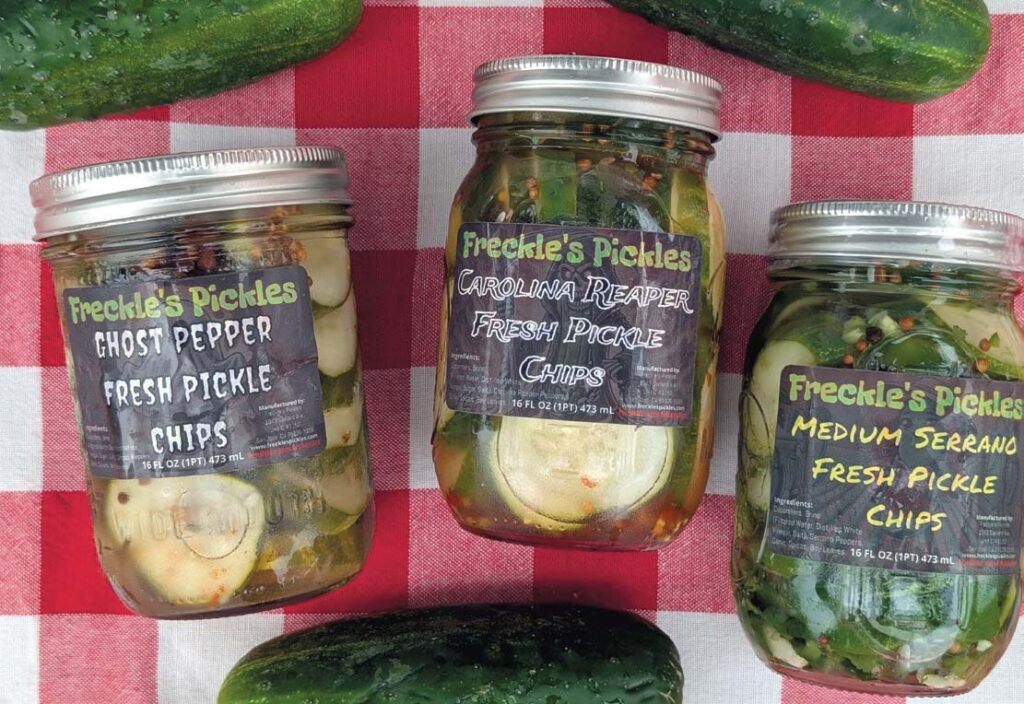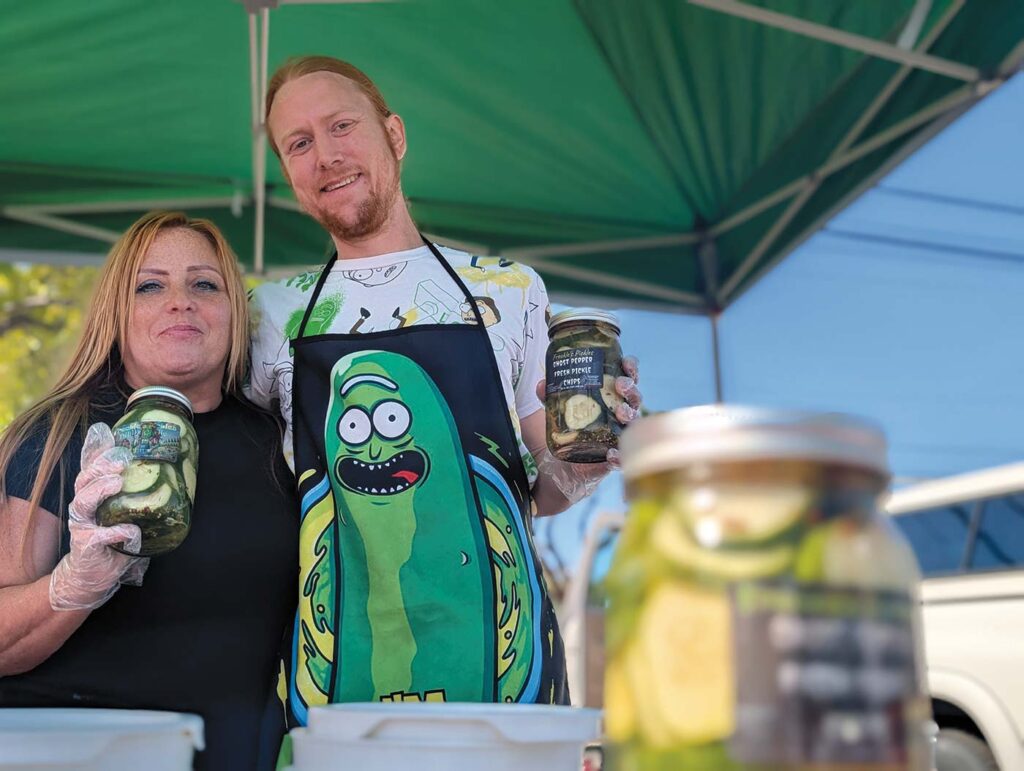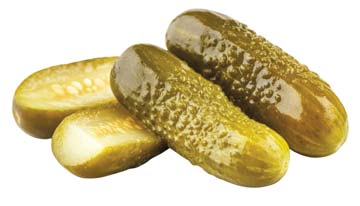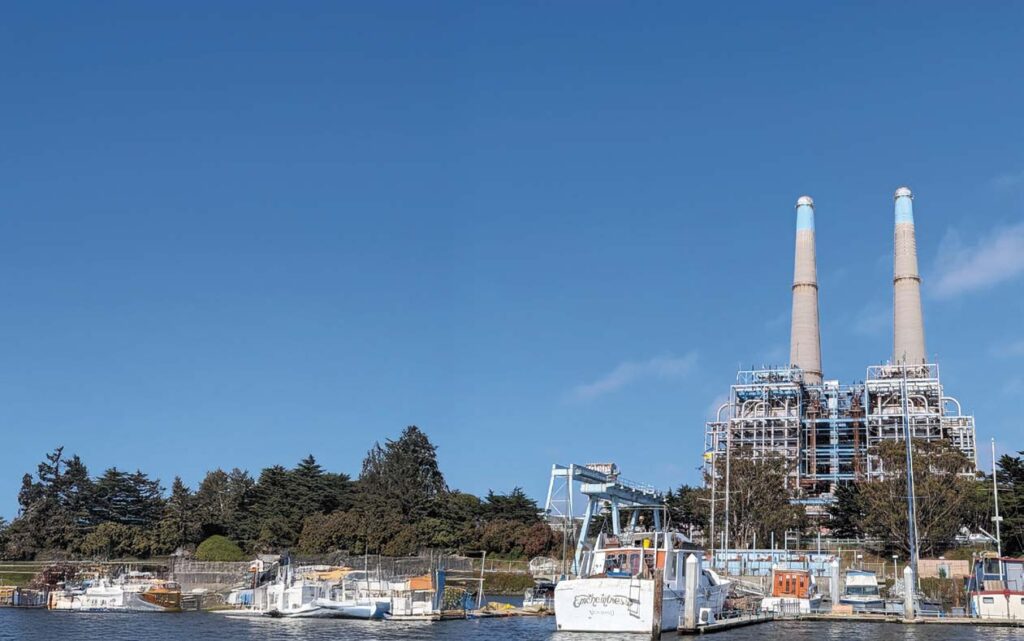
PHOTOGRAPHY BY OTIS CONKLIN
While many of us spent the early days of the pandemic hoarding toilet paper, collecting unemployment and experimenting with sourdough, Chris Ley was launching a business.
It wasn’t a conscious decision, at first.
But for the founder of Royal Oaks-based Freckle’s Pickles, the pandemic-driven food supply shortages sparked a desire to become more self-sufficient—and take his future into his own hands.
Ley was working as a lab tech manager in March 2020, and his wife-business partner Debbie was a hairstylist who found herself out of a job due to COVID closures.
The couple soon decided to take on growing their own vegetables for the first time, and planted “a little of everything,” including a dozen types of pickling cucumbers.
“I had no idea there were so many varieties,” says Ley, a selftaught cook who, at the time, had never tried preserving food.
He threw himself into gardening, reading up on how to build and amend soil—and preserve produce.
Meanwhile Ley learned to cook, educated and inspired in part by watching The Food Network on overnight shifts as a home health caregiver.
Inspiration also emerged when his boss, whom Ley describes as “a very frugal guy,” came in with expensive fresh pickles from Whole Foods.

I thought, ‘If he’s spending this much on pickles, they must be good,’” Ley says. “They blew my mind.” Ley embarked on making his own fresh pickles sourced from his garden. He began giving them as gifts to coworkers and friends and, he remembers, “They went nuts.”
“They started asking if they could buy them and it became a running joke that I was going to start a pickle company,” Ley says.
The couple was, in fact, struggling to get by on a single salary, so Ley made a decision to go all in on launching a pickle company. In October of 2021, the Leys debuted their homegrown and homemade products at a makeshift stall on Pacific Avenue in Santa Cruz.
At the moment, Freckle’s Pickles can be found at 10 farmers markets throughout Santa Cruz, Monterey and Santa Clara counties, as well as Shopper’s Corner in Santa Cruz, Barn Fresh Produce in Moss Landing, Radici Market in Carmel Valley and Quality Market & Liquors in Salinas, as well as the odd brewpub.
Debbie continues to be surprised at the raw enthusiasm they encounter as they pass out samples and, often enough, a small crowd forms.
“People’s reactions have been crazy!” she says, noting the uncooked crispness of their style has been a difference maker. “I had no idea people were going to be like, ‘Oh my gosh! These pickles!’”
The success of Freckle’s Pickles—“My wife and I are both redheads,” Ley explains— is more than coincidence or timing, however.
“My entire life, I’ve been very passionate about books like Napoleon Hill’s Think and Grow Rich!,” he says. “I’m a big believer in the power of positive thinking, and I thought, if my coworkers believe in me, I can do this.”
After the Leys started their pickle business, they were sourcing a portion of their cucumbers from their home garden, a practice that continued until Jan. 16, when the Moss Landing Battery Fire happened (see below). The remaining cucumbers and other produce (garlic, chiles and herbs) come from growers throughout California, with an emphasis on Monterey County.
After the fire, the couple stopped using their homegrown produce, which include additive-free flavors like Dill-Garlic, Mild Jalapeño, Hot Habanero and Carolina Reaper.
“We change people’s minds about pickles every day.”
“People kept asking for hotter varieties,” says Ley, who adds a bit of sugar for balance. The company also offers a sugar-free medium serrano, while Ley works on developing sweet and classic dill relishes, and a sweet pickle.
What proves ubiquitous along the way is the process Ley uses to make his products— avoiding the method of heating through pasteurization to make them shelf stable, or adding dyes.
“‘Shelf pickles lack the health benefits of other types of pickles because the heat destroys the good bacteria as well,” he says.
Part of what sets Ley’s fresh pickles apart from their fermented brethren is their bright green color and snappy texture. Ley keeps his exact recipe secret, but notes that he uses mostly organic ingredients along with kosher salt and distilled white vinegar.
“The magic is in the brine,” says Ley, adding that the use of fresh herbs also amps up the flavor.
Freckle’s Pickles are made in a commercial kitchen in Santa Cruz, though Ley has plans for extended production.
“I want to grow organically, eventually expanding to other regions and sourcing locally within those regions to support farmers,” he says.
As far as the immediate future goes, Ley is plenty busy just making pickles.
“They’ve become my passion—my wife says I was meant to do this, although I couldn’t have done it without her,” he says. “If you have a positive mindset, a small business can become a self-fulfilling prophecy, even with something as random as this. We change people’s minds about pickles every day.”

PICK A PECK
A primer on pickle styles
Fresh: Also known as refrigerator or cold cured pickles, these crunchy pickles are made by soaking cucumbers in a vinegar-based brine at room temperature, have probiotic benefits and work as garnishes, snacks and grazing board accents.
Fermented: Also called kosher or half sours, brined in vinegar at room temperature, have the highest probiotic content, and moderate crunch, great in sandwiches or on a charcuterie spread.
Shelf stable: Pasteurized (heated) and made with vinegar. The application of heat destroys good bacteria, can be made with dyes and additives, have a softer texture.

QUIET BURN
The fallout of the Battery Fire smolders on
On the afternoon of Jan, 16, a fire broke out at the world’s largest lithium storage facility, located in Moss Landing. The incident prompted the evacuation of more than 1,000 residents.
The fire resulted in a class-action lawsuit by several Moss Landing parties against Vistra Corp, the Texas-based power company that owns the facility. According to a memo from the office of John Laird, California state senator for District 17, the California Department of Toxic Substances Control (DTSC) conducted preliminary soil testing at select sites near Moss Landing, with surface screenings of ash and debris detecting elevated levels of heavy metals, and deeper soil samples and sites further from the fire revealing no higher concentrations.
In the hours, days and weeks after the fire, Moss Landing residents complained of various ailments.
Those included a metallic taste in their mouth, headaches, nosebleeds and sore throats. In addition to heavy metals, lithium-ion battery fires release carbon monoxide, hydrogen fluoride and volatile organic compounds that carry the potential for serious respiratory and neurological issues, particularly in children, the elderly and those with compromised immune systems.
Researchers from San Jose State University’s Moss Landing Marine Laboratories (MLML) have discovered an increase in heavy metals in the Elkhorn Slough Reserve, adjacent to the battery plant.
“It’s clear that much of the heavy metals resulting from the battery fire are from aerosol fallout,” says Ivano Aiello, professor and chair at MLML.
Aiello and his team have, during their study, been testing the soil, water and invertebrates of the slough. Following the main precipitation events in February, his team started noticing a dramatic decrease in surface concentrations, he adds.
“There were also larger visible burned fragments found up to 3 kilometers away from the site of the fire,” he says. “The surface of the soil also contained very small particles of metallic material that is used to make cathodes in batteries.”
He also notes that the increase in concentration of manganese, nickel and cobalt in the marsh soils was two to threefold compared to previous measurements, most of which were done in the summer of 2023.
As a result of the fire, Senator Laird introduced the Clean Energy Safety Act of 2025, which aims to, among other objectives, increase battery storage safety. His office continues to collaborate with local officials to “amplify their requests at the state level and advocate for further resources,” which includes helping to secure outside funding for MLML to conduct environmental testing.
QUOTE Farmer Delmar McComb says he is “deeply disturbed” by this incident.
Many of the region’s farmers, however, have been left to deal with the fallout on their own.
Delmar McComb of Blossom’s Farm has two sites on Jensen Road in Moss Landing. The farm, which grows herbs, vegetables and strawberries, eschews chemicals and uses biodynamic practices, including making herbal plant health tonics, growing cover crops for soil improvement and using certified organic inputs when needed.
Although their sites are upwind of the fire, McComb says he is “deeply disturbed and frustrated by this incident.”
He and his business-life partner Carin Fortin paid more than $500 out of pocket for soil testing to ensure their land was safe. The results confirmed that the farm didn’t suffer any contamination as a result of the fire, although McComb plans to retest.
McComb does, however, note that the metals resulting from the fire are naturally occurring in the human body and in soil. “Just as with human health, some metals, in small quantities, are required by plants in order to assimilate other nutrients,” he says. “Obviously, heavy concentrations of metals in the soil or body are toxic, but low levels are normal. Our soils tested low or very low on all, so we feel good about the results.”
The farm also reports that no state or local agencies have reached out since the fire. When Edible Monterey Bay contacted California Certified Organic Farmers (CCOF) for comment, reps referred to the organization’s official statement.
“CCOF has been in communication with the California Department of Food and Agriculture (CDFA) State Organic Program (SOP) and Monterey County agricultural officials,” it reads. “At this time, CCOF, the SOP and the Agricultural Commissioner’s Office are not conducting independent sampling.
However, the County Environmental Health Bureau is analyzing soil samples collected by DTSC and sharing results with county officials. CCOF has contacted all operations that it certifies within a three-mile radius of the incident and, to date, has not identified contamination of organic land as an issue.”
Edible Monterey Bay will keep readers updated on the agricultural and marine effects of the Battery Fire as they develop, via ediblemontereybay.com.
About the author
Laurel Miller is a food, spirits and travel writer and the former editor of Edible Aspen. She grew up on a California ranch and has been writing about regenerative agriculture for over 20 years. When she’s not tethered to her laptop, Miller enjoys farmers markets and any trip that requires a passport. She’ll take a Mission burrito over a Michelin star, any day.
- Laurel Millerhttps://www.ediblemontereybay.com/author/laurelmiller/
- Laurel Millerhttps://www.ediblemontereybay.com/author/laurelmiller/
- Laurel Millerhttps://www.ediblemontereybay.com/author/laurelmiller/
- Laurel Millerhttps://www.ediblemontereybay.com/author/laurelmiller/



